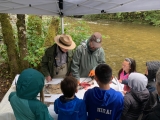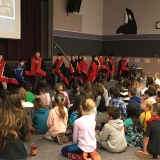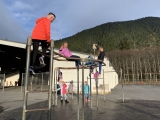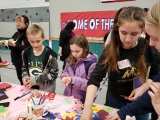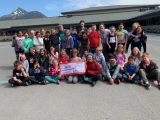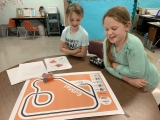-
Category 1
Selected in 2020
-
Grades: 2 - 5
School Setting: rural
Town Population: 8,500
Student Enrollment: 303
Student Demographics:
Black/African American: 1%
Teacher/Student Ratio: 1:12
White/Caucasian: 52%
Hispanic: 4%
Hawaiian/Pacific Islander: 8%
Asian: 1%
Native American: 33%
Other: 1%
% Reduced Lunch: 43%
% ELL Learners: 8%
Founded: 1987 -
PRINCIPAL:
Casey Demmert -
CONTACT:
307 Kashevaroff Street
Sitka, AK 99835
907-747-8395
demmertc@sitkaschools.org
Keet Gooshi Heen Elementary School
Sitka, AK
Students at Keet Gooshi Heen (KGH) thrive in a welcoming and supportive school that provides a rich and varied curriculum.
- Describe the most successful activity your school has initiated to strengthen ties to your community.
-
KGH faculty, staff and leadership recognize the single greatest impact on a student’s success is their family, and the school cultivates positive partnerships with families. Families often extend student learning through after school or summer programs, or through quality home practice provided by classroom teachers. KGH enjoys an average 95% participation rate at parent-teacher conferences, and families are welcome in the school or their children’s classroom at any time.
Sadly, Alaska is the state with the highest level of domestic violence in the nation. To help the community break this cycle, KGH works with the local domestic violence agency to offer prevention and empowerment programs for young children. These after school programs, Girls Run and I Toowu Klatseen/Boys Run, teach healthy relationship skills within the context of cultural values, embedded in a non-competitive running program.
In an effort to combat the generational trauma in our community, along with the trauma related to Alaska’s high rates of domestic violence, Sitka School District was awarded a grant focused on improving equity. The Supporting Transitions and Educational Promise Southeast Alaska (STEPS Alaska) grant seeks to engage the community, especially young families new to the district, to better support students before they enter district classrooms. This includes a Kindergarten bridge program in the summer, focus groups with a number of stakeholders, and frequent family engagement activities. While this grant is district-wide, it is having direct, if gradual positive impacts on Keet Gooshi Heen students.
Even before the STEPS grant formalized some of the community partnerships at KGH there was a strong bond between the community and the school. Wednesdays are Fish to Schools day, when students can choose locally-caught fish for their hot lunch, a program coordinated by the Sitka Conservation Society. The Sitka Sound Science Center connects visiting scientists to each classroom at least once each year, and the Alaska Maritime National Wildlife Refuge annually provides additional place-based lessons about the flora and fauna found in the refuge adjacent to Sitka. Families volunteer each spring to host the school carnival, held on the last day of the school year, a very popular tradition at KGH. The Sitka Fine Arts Camp assists with the management of the Artists in Schools Residencies, offered through the Alaska State Council on the Arts, and they bring a number of performers to school stages across the district throughout the year. The Alaska Marine Safety Education Association provides instructors to lead KGH students in learning the survival skills essential to life in the wilderness environment of Sitka. Community partnerships are a hallmark of Sitka School District, and KGH is a showcase for the power of these partnerships.
In short, Keet Gooshi Heen is an inviting place for every kind of student to learn, and our students and values reflect the community we serve. The many and varied volunteer programs and partnerships at KGH and throughout the district enrich students and provide for the well-rounded background that leads to well-rounded citizens.
- Explain how ESEA federal funds are used to support your improvement efforts.
-
Title I services are deeply and seamlessly integrated into KGH students’ broad educational experience. Title-funded reading intervention is just one on a continuum of services in the Multi-Tiered System of Support provided to ensure all students succeed. Title I funds provide only a portion of the reading specialists’ positions, serving those students with the highest needs. The same interventionists also provide less intensive services to students with lower needs, and students move in and out of Title I services as their progress indicates. Title I funds also support academic achievement for students who experience homelessness by providing necessary resource materials. Students who are eligible for migrant education receive Title IA services on the same basis as all students, and additional resources funded by Title IC as needed.
Keet Gooshi Heen provides instructional services to students eligible for Title I services through a variety of evidence-based curricular and instructional strategies and assessments. A variety of explicit instruction techniques are employed to offer additional learning opportunities for students who struggle in reading. Formative and summative achievement data are used to drive instruction and identify students in need of additional resources and time in a small group intervention setting. Data review and progress monitoring are ongoing, not only for student groups working with the Title I intervention specialists but for all students, including those identified as English language learners or in special education, to ensure students are proficient in reading by third grade. If a student is falling behind, additional interventions are implemented to address their individual needs. Group participation and materials are adjusted based on results of frequent progress monitoring.
In addition, the reading intervention team provides a wide array of professional resources to all teachers, as well as assisting to interpret data regarding progress in reading. The reading intervention team meets regularly with grade level teams and specialists (English learner, special education, etc.) to analyze data, place students appropriately, recommend resources, and consult on the needs of individual students. At KGH, Title I resources are equitably disbursed according to individual student need.
- Identify the critical professional development activities you use to improve teaching and student learning.
-
Research shows that high quality professional development is sustained, intensive, and classroom-focused. It is collaborative, job-embedded, and data-driven. When professional learning is evidence-based it enhances the professional practice of educators, and at KGH we see the student growth that results.
After reading scores failed to improve over many years, KGH improved the system of assessment to include the Dynamic Indicators of Basic Early Literacy Skills (DIBELS) and the Measures of Annual Progress (MAP) Growth and MAP Reading Fluency. Using the diagnostic information from these assessments, and working with a reading consultant and the professionals at MAP, classroom teachers have learned to interpret and fully utilize data at the student level. This work has contributed to KGH students making 60-70% growth on the nationally-normed MAP Growth assessment.
For the past decade Sitka School District has used the School Climate and Connectedness Survey to determine how students are feeling about their school experience. Along with data collected through a previous anti-bullying program, SSD recognized a negative trend in student-school connectedness in the district. The district then contracted with behavior specialist Dr. Diana Browning Wright to help analyze the data on a deeper level, and to collect more data through the Brief Externalizing and Internalizing Screener for Youth tool (BEISY). The information from this screener allows teachers to see which students are displaying externalizing (disruptive, aggressive or oppositional behavior) or internalizing (withdrawn, negative self/school talk, or internalizing emotional problems) behaviors, or both. With this information the Student Intervention Matching System (SIMS) is used to determine the best interventions for each student. This form includes statements assessing a variety of student characteristics that align with performance-based Tier II interventions. The responses are then scored to determine which evidence-based Tier II interventions should be considered to address the student’s emotional and behavioral needs. Keet Gooshi Heen is actively working to implement the recommendations of Dr. Browning Wright, and to determine where the academic and social emotional data tools converge in order to target support to the most at-risk students.
Through a multi-year partnership with the Sitka Fine Arts Camp and the University of Alaska Southeast, funded by private philanthropy, KGH teachers are receiving deep professional learning focusing on teaching in and through arts, culture, and technology (ACT). ACT integration has been shown to increase achievement, especially for students who are economically disadvantaged and ethnic minorities. The theory of change is that early career teachers who receive ACT integration training, and who are supported by an environment of ACT integration, will develop strong pedagogical skills in teaching in and through the arts, which will in turn result in increased learning. ACT professional learning is available on and off contract hours, and is supported by additional classroom resources such as supply kits and artist residencies.
Even with the responsiveness of the district and KGH leadership to the data and professional learning needs of the faculty, teachers are encouraged to seek additional professional development opportunities that are tailored to their unique needs through a grant process using dedicated district funds. Using a rubric that encourages disseminating learning upon return from the professional development event, a teacher-led team evaluates applications and awards grants to their peers. This allows teachers to direct their own learning, and to bring back important tools and trends to share with colleagues. Working in tandem, the Sitka School District and the staff of KGH are using evidence-based professional learning to close achievement gaps and increase student success.
- Describe how data is used to improve student achievement and inform decision making.
-
Teachers at Keet Gooshi Heen Elementary School (KGH) are empowered and encouraged to make instructional decisions based on the extensive use of data. The Sitka School District (SSD) has a comprehensive assessment system in place, including Universal Screeners for ELA, Math, and behavior. To support the use of this data, SSD has adopted the full suite of PowerSchool products, including not only the Student Information System but the Learning Management System and the Performance Matters analytics tool. The goal of this significant investment is to democratize data, putting it in the hands of professional educators who will use it best. This combination of the district providing tools while entrusting quality instruction to the faculty situates Keet Gooshi Heen in the sweet spot of significant and sustained student growth toward competency on the rigorous Alaska Standards.
Staff at KGH have capitalized on the district’s commitment to small class sizes by providing differentiation within classrooms and leveraging faculty positions to provide for specialists in reading intervention and science. KGH supports students to become proficient in reading by third grade, by providing a Multi-Tiered System of Support including evidence-based core Tier I curriculum and practices, Walk to Read leveled reading groups for Tier II intervention, and individual Tier III interventions with certified reading specialists, partially funded by Title I. Students at KGH apply core class skills, such as reading and math, in the dedicated STEM classroom, where Alaska’s science and computer science standards are brought to life.
Sitka School District has provided the tools and the time for the professional educators at Keet Gooshi Heen to collect and use data to guide instruction. Through three annual administrations of the universal screener MAP Growth, teachers are able to diagnose not only the instructional level of each student, but appropriate next steps for instruction at all three tiers of support. Additional tools in use at KGH are the DIBELS and MAP Reading Fluency for reading-specific information, the WIDA ACCESS for English learners, and a number of blended learning programs in math, such as Prodigy and Khan Academy, as well as math intervention to support the school’s math curriculum. By using multiple data points to target support to the individual needs of each student KGH experiences strong student engagement and sustained growth for all. In a continuous improvement cycle of curriculum review, materials are reviewed and recommended by committees of practicing teachers from all grade levels, ensuring vertical alignment of basic instructional materials.
An area of deep and growing focus for SSD and KGH Elementary is the social-emotional needs of Sitka’s students. KGH teachers and staff work closely with the lower elementary to support student transitions between grade levels and buildings. Sitka School District formed a partnership preschool several years ago that merges the efforts of the community’s Head Start program with the local tribal entity and the SSD preschool special educators to create a culturally-responsive and trauma-informed free, public preschool, Wooch.een Yei Jigaxhtoonei. Working with data collected from the School Climate and Student Connectedness Survey administered in the District annually, KGH staff are also using a screener to identify students who may need Tier II emotional and social support. Research clearly shows a convergence of Maslow’s Hierarchy of Needs with Bloom’s Taxonomy of complex learning objectives, and through measures such as the full-time counselor at KGH, the district’s intentional focus on social-emotional and culturally responsive learning, and the trauma-informed and culturally-responsive teaching practices found at coupled with data, learners feel supported, and are challenged academically.
- Describe your school culture and explain changes you’ve taken to improve it.
-
I believe this would be a culture of acceptance, high standards and diverse opportunity for students. Students at Keet Gooshi Heen (KGH) thrive in a welcoming and supportive school that provides a rich and varied curriculum. Title I funds are integrated to serve students who show a need for Tier III support in reading, regardless of their socio-economic status. A breakfast and lunch program, as well as a variety of community partnerships, support students in poverty, homeless students, and English learners.
Along with the district and community’s commitment to small class sizes to create the most effective learning environment, students at KGH participate in music, physical education, Science, Technology, Engineering, and Math (STEM), and library classes taught by specialists. Taking advantage of Artists in the Schools, a state-funded matching program that offers grants to bring practicing artists into the schools. Students learn library sciences from a qualified librarian, and enjoy programs such as Battle of the Books, lunchtime book clubs, and Read Across America. The STEM program has offered an annual Project Fair for nearly 30 years, where students showcase long term projects of their own choosing, many of them in science. The school’s STEM specialist provides weekly hands-on lessons to each class, as well as offering enrichment to identified students in the gifted program.
Fourth grade students may participate in a voluntary choir (roughly 40% of fourth graders choose to exchange two recesses a week in order to make more music), in addition to weekly classes in music, and all students in the school perform in an annual grade-level concert. In recognition of the many cultural groups in the community, each concert includes songs from a variety of local traditions. Fifth grade students may choose to participate in band, which meets during school and after school in order to be an inclusive option for all families; for over two decades 75-85% of KGH students, including intensive needs students, have participated in the band program. The band performs three times each year, with a nearly full house at each performance.
Even with a free and reduced-price lunch rate of over 40%, KGH students are provided the meals and healthy snacks they need to succeed in school. Sitka School District offers nutritious breakfast and lunch options to all students, including a full salad bar daily. KGH also participates in the federally-funded Fresh Fruit and Vegetable Program to provide wholesome snacks each morning. KGH students are further supported by a weekly volunteer-led supplemental food program that provides student-friendly foods for the weekend during the school year.
English language learners are supported by a specialist, with a particular focus on the needs of the increasing population of newcomers. As a result of KGH’s commitment to a rich and varied curriculum, alongside specialist support, 100% of English learners have met growth targets toward fluency in the past two years, as measured by the state’s Department of Education and Early Development.
The KGH playground has inclusive equipment, and the district provides physical therapy, occupational therapy and a swimming program to qualified students. There are four special education teachers at KGH, a speech and language pathologist, and a team of paraprofessionals who provide a bridge between students with intensive special needs and success in the least restrictive environment. Students with intensive emotional needs are supported during school by staff from outside behavioral health agencies and a full-time school counselor. As a result of these coordinated efforts within KGH, according to statewide testing in 2019, the proficiency rate for students with disabilities more than doubled on the PEAKS in English Language Arts from the previous year. With their focus on the success of all learners, KGH received the 2015 Alaska Inclusive Practices Award.
Stats
-
Category 1
Selected in 2020
-
Grades: 2 - 5
School Setting: rural
Town Population: 8,500
Student Enrollment: 303
Student Demographics:
Black/African American: 1%
Teacher/Student Ratio: 1:12
White/Caucasian: 52%
Hispanic: 4%
Hawaiian/Pacific Islander: 8%
Asian: 1%
Native American: 33%
Other: 1%
% Reduced Lunch: 43%
% ELL Learners: 8%
Founded: 1987 -
PRINCIPAL:
Casey Demmert -
CONTACT:
307 Kashevaroff Street
Sitka, AK 99835
907-747-8395
demmertc@sitkaschools.org



